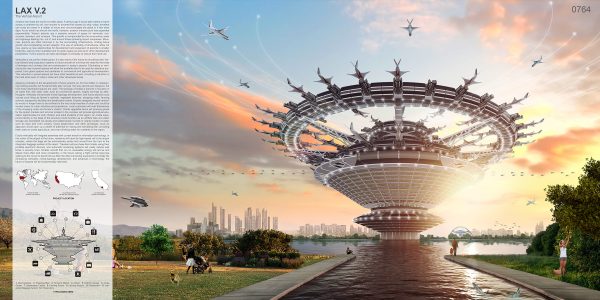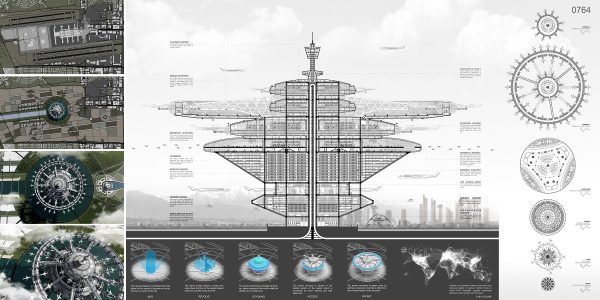Honorable Mention
2018 Skyscraper Competition
Jonathan Ortega
United States

Aviation has made the world a smaller place. A century ago it would take weeks to travel across a continent by rail, and months to traverse the oceans by ship; today, travelers can cross an ocean in a matter of hours and circumnavigate the globe in a few short days. As air travel has shrunk the world, however, aviation infrastructure has expanded exponentially. Today’s airports use a massive amount of space for terminals, concourses, taxiways, and runways. This growth is compounded by the surrounding roads and highways feeding into, out of, and around these sprawling airport complexes. Moreover, airports are often hemmed in by the surrounding infrastructure, limiting future growth and complicating current designs. The use of verticality of structures, while not new, opens up new opportunities for development and expansion of airports into smaller footprints, leaving more available land for green space as well as for other development possibilities. Future airports can take advantage of verticality to reduce their land use.
Verticality is not just for infrastructure; it is also the wave of the future for aircraft as well. Vertical takeoff and propulsion systems in future aircraft will minimize the need for the kinds of taxiways and runways that are omnipresent in today’s airports. Eliminating or minimizing the use of paved spaces will allow the available land to be used for alterative purposes, from green spaces and parklands to commercial and agricultural development. This reduction in paved spaces will have other benefits as well, including a reduction in the heat sinks seen in today’s cities and other developed areas.
Applying verticality to the development of future airports (or, for that matter, to redesigning existing airports) will fundamentally alter not just the way airports are designed, but how those developed spaces are used. The typology of today’s airports is focused on air travel first, with other uses, such as commercial spaces, largely serving as afterthoughts. Verticality will promote mixed-typology development, and future airports could include such things as farmer’s markets, farming factories, shopping malls, farming schools, aquaponics facilities and desalination plants. Airports designed around verticality would no longer have to be confined to the very outer reaches of urban areas and could be located closer to urban activities and populations. Local customers will avail themselves of the shopping malls and farmer’s markets. Onsite farm factories will produce goods for the airport markets, and schools located in the complex will provide agricultural education opportunities for both children and adult students in the region. An onsite artificial lake in the base of the structure could function as a water storage area connected via canals and subterranean tunnels to nearby bodies of water such as bays and even oceans. Using desalination, aquaponics and other processes, such an approach would open-up a wealth of potential for raising and harvesting fish, providing fresh water for onsite agriculture, and even drinking water for residents in the region.
Future verticality will integrate seamlessly with current trends in the information technology. In this vision of the airport of the future, residents will travel by high-speed rail to the airport complex, where their bags will be automatically sorted and moved from the train to the integrated baggage system at the airport. Travelers will purchase their tickets using their portable electronic devices, and automatic screening systems will vastly reduce wait times in security lines. Smaller aircraft that run on renewable energy will arrive and depart more often and more consistently; in the future, taking a flight will be more like walking to the corner to board the bus than the often-harrowing experience it is today. By embracing verticality, mixed-typology development, and advances in technology, the future of airports will be fundamentally reformed.


This work is licensed under a Creative Commons License permitting non-commercial sharing with attribution. https://creativecommons.org/licenses/by-nc-nd/4.0/



